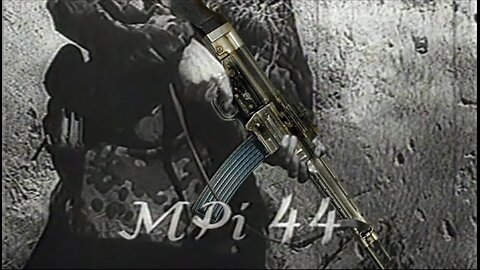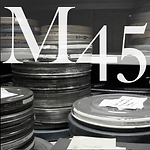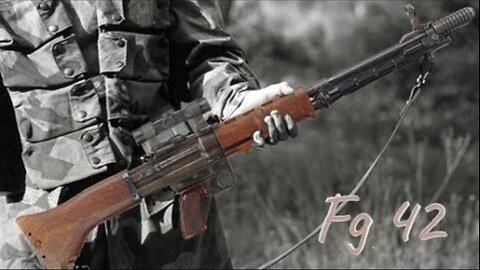
-
Cassino Pt. 1 - StG 44 assault rifle - Mp 40 - German 1st Paratrooper Div. Green Devels - Kesselring
 Military1945SUPPORT THE CHANNEL and get access to exclusive film footage www.Patreon.com/Military1945 This footage is from the 1944 German training film called Nahkampf mit Waffen, or Close combat with weapons. At the end of this video I’ll be showing more so stick around, it’s worth it. Using articles from early 1944 from the periodical series Die Wehrmacht in two videos I’ll be focusing on the second battle for Cassino and related subjects. If you’d like to get notified of future videos go ahead and subscribe to the channel and click the bell icon. This illustrated relief map shows the lay of the land around Cassino and the approximate positioning of the enemy during the second battle for Cassino which took place in Feb. of 1944. To the left in front of the city Cassino, runs Street Nr. 6 which leads to Rome. Behind that Mnte. Cassino and the monastery that was destroyed by the enemy. Farther back behind Mnte. Cassino is Mount Cairo which is about 2000 meters hight. The enemy tried several times to occupy areas to the north and east of Cassino City on this mountain. Down the middle is the Tal von Rapido, or Rapido Valley, which was partially flooded. This is the direction that the enemy thrust to take Cassino came from. These are scenes of Cassino City after days of intense often door-to-door street fighting. This particular footage is from a Portuguese source. This is Fieldmarshal Albert Kesselring meeting with General Richard Heydrich the commander of the 1. Fallschirmjäger or paratrooper, Division. It’s interesting to see that this notice was issued by the so-called Strassenkommandant, or Street commander. The first phase of the battle was highlighted by intense artillery duels. The Americans had a heavy superiority in firepower which they had hoped would compel the Germans to withdraw their forces from the Cassino area. They also enjoyed air superiority. This is captured footage of American artillery gun crews in action during the battle. The Germans, however, understood that losing Cassino would leave Rome vulnerable to the Anglo-American advance which would have to be avoided at all cost. This is a heavy Nebelwerfer, or rocket launcher, that has just been loaded. Notice the interesting camouflage pattern that it’s been painted with. This nice photograph shows a frontal view of a Werfer with rockets loaded and ready to fire. The Germans had the advantage of being well dug in and the mountainous terrain provided excellent elevated and unobstructed lines of sight for their artillery spotters who could call in pre-determined coordinates to their artillery batteries and quickly target groups of assault troops that had been gathering for attacks with devastating pinpoint accuracy. Many of these crews had seen extensive combat on the Eastern Front and so were generally more experienced than their Anglo-American counterparts. In 1943 the Germans had made a public commitment not to place military personal inside the monastery but as the casualties mounted, frustrated American leaders began to believe that the it was in fact occupied, at least by artillery spotters, and so they decided to bomb it. The monastery was destroyed but the German’s were not intimidated. Rather than withdrawing the German 1st Fallshirmjäger Division immediately occupied the rubble which proved to be an excellent defensive position. On Feb. 8 the Americans began a third and final assault on Cassino town and Monastery Hill. In the town intense street fighting broke out resulting in heavy casualties being taken by both sides. Here is more Anglo-American footage that was taken during that fighting. This is the American general Mark W. Clark. I’ll be uploading the second video soon so remember to subscribe to the channel. And now here is more of the close combat with weapons training film that I promised. If you are a Patreon channel member you’ll receive a link to an additional clip. If you are not yet a member please consider becoming one. Thanks for watching.112 views
Military1945SUPPORT THE CHANNEL and get access to exclusive film footage www.Patreon.com/Military1945 This footage is from the 1944 German training film called Nahkampf mit Waffen, or Close combat with weapons. At the end of this video I’ll be showing more so stick around, it’s worth it. Using articles from early 1944 from the periodical series Die Wehrmacht in two videos I’ll be focusing on the second battle for Cassino and related subjects. If you’d like to get notified of future videos go ahead and subscribe to the channel and click the bell icon. This illustrated relief map shows the lay of the land around Cassino and the approximate positioning of the enemy during the second battle for Cassino which took place in Feb. of 1944. To the left in front of the city Cassino, runs Street Nr. 6 which leads to Rome. Behind that Mnte. Cassino and the monastery that was destroyed by the enemy. Farther back behind Mnte. Cassino is Mount Cairo which is about 2000 meters hight. The enemy tried several times to occupy areas to the north and east of Cassino City on this mountain. Down the middle is the Tal von Rapido, or Rapido Valley, which was partially flooded. This is the direction that the enemy thrust to take Cassino came from. These are scenes of Cassino City after days of intense often door-to-door street fighting. This particular footage is from a Portuguese source. This is Fieldmarshal Albert Kesselring meeting with General Richard Heydrich the commander of the 1. Fallschirmjäger or paratrooper, Division. It’s interesting to see that this notice was issued by the so-called Strassenkommandant, or Street commander. The first phase of the battle was highlighted by intense artillery duels. The Americans had a heavy superiority in firepower which they had hoped would compel the Germans to withdraw their forces from the Cassino area. They also enjoyed air superiority. This is captured footage of American artillery gun crews in action during the battle. The Germans, however, understood that losing Cassino would leave Rome vulnerable to the Anglo-American advance which would have to be avoided at all cost. This is a heavy Nebelwerfer, or rocket launcher, that has just been loaded. Notice the interesting camouflage pattern that it’s been painted with. This nice photograph shows a frontal view of a Werfer with rockets loaded and ready to fire. The Germans had the advantage of being well dug in and the mountainous terrain provided excellent elevated and unobstructed lines of sight for their artillery spotters who could call in pre-determined coordinates to their artillery batteries and quickly target groups of assault troops that had been gathering for attacks with devastating pinpoint accuracy. Many of these crews had seen extensive combat on the Eastern Front and so were generally more experienced than their Anglo-American counterparts. In 1943 the Germans had made a public commitment not to place military personal inside the monastery but as the casualties mounted, frustrated American leaders began to believe that the it was in fact occupied, at least by artillery spotters, and so they decided to bomb it. The monastery was destroyed but the German’s were not intimidated. Rather than withdrawing the German 1st Fallshirmjäger Division immediately occupied the rubble which proved to be an excellent defensive position. On Feb. 8 the Americans began a third and final assault on Cassino town and Monastery Hill. In the town intense street fighting broke out resulting in heavy casualties being taken by both sides. Here is more Anglo-American footage that was taken during that fighting. This is the American general Mark W. Clark. I’ll be uploading the second video soon so remember to subscribe to the channel. And now here is more of the close combat with weapons training film that I promised. If you are a Patreon channel member you’ll receive a link to an additional clip. If you are not yet a member please consider becoming one. Thanks for watching.112 views -
Monte Cassino Pt 2 - Fg 42 - Otto Skorzeny - Mp 40 - Panzerfaust - StG 44 - Fallschirmjäger - Sniper
 Military1945SUPPORT THE CHANNEL and get access to exclusive film footage www.Patreon.com/Military1945 This incredible footage is of German Fallschirmjöger, or paratroopers training was produced in Vichy France in 1943. It fits in well with the second video covering the Battle of Monte Cassino which took place in early 1944. In addition to the rare combat footage I’ve added absolutely unique footage showing a Fallschirmjäger armed with the Fg 42 assault rifle in the wild. This damaged fresco was part of the Cassino Monastery which was bombed by the Anglo-Americans out of frustration when they believed that German artillery spotters had occupied the monastery were calling in devastating strikes from there. This is a clip from one of the few original color new reels that was produced by the Germans during the war. It was taken in Italy in 1944. The complete newsreel has a runtime of 13:52. This fascist Dutch newsreel focuses on combat involving the Fallschirmjäger at Cassino. We can identify the Fallschirmjäger by the characteristic shape of their helmets which were designed to give them less obstructed peripheral sight. Peripheral sight was enhanced because, during a parachute jump, they would likely be alone or in small groups during those first moments on the ground. These are captured Zew Zealanders. The attacking force was made up of soldiers from the United State, the United Kingdom, New Zealand, Poland, Free France, Canada, South Afrika, India and even some Italians. The Fallschirmjäger were part of the German Luftwaffe, they were elite formations and they were intended to be used in special operations. The most important operations that they had been involved in include the taking of Narvik in Norway, the fortification Eben Emael in Belgium, bridges at Moerdijk and Dordrecht in the Netherlands and then finally on the Greek island of Crete where they suffered terrible casualties. This would prove to be their last large airborne operation. Over time I’ll certainly be doing videos on each of these operations so if you haven’t subscribed yet please go ahead and do that and hit the bell icon. Also please like this video, that only takes a second. A Patreon member asked if I had any footage containing the rarest gun of the war, the German Fg 42 which was developed specifically for the Fallschirmjäger…and there it is. I’d love to be able to offer you a better view or even show it firing but that’s all I could find. At least the picture quality is good. The weapon was developed after operation Merkur, the invasion of Crete, had shown that the Fallschirmjäger needed an easily portable rapid fire weapon capable of engaging targets at medium or even long range. Although Hitler had ended such large scale airborne operations because of the casualties suffered, Göring, the head of the Luftwaffe secretly supported the weapon’s development. It’s first operational use came in September of 1943 when a group of SS and Falschirmäger lead by Otto Skorzeny freed Mussolini from captivity. Here is a photo of a Fallschirmjäger with armed with an Fg 42 in front of a glider used during the operation. If you are a Patreon Channel Member I’ll send you a link to further exclusive footage of the fighting at Cassino. If you are not yet a member, please consider becoming one. It’s worth it, I promise. Also, if you go to the associated website at Military1945.com you can open an account for free and you’ll get access to some of the situational maps for the eastern front. Channel Member get access to all those maps. At Cassino the Fallschirmjäger came to be known as the Green Devils because of the color of their uniforms and their ferocity. Finally the third and final battle to take Monte Cassino came to an end on May 18, 1944. Although the Allies were victorious, the battle had raged on for 4 months and 1 day and had cost them 50,000 casualties while the Germans had suffered 20,000. It’s estimated that about 20,000 civilians were killed. The Italian front certainly diverted German men and resources away from the Atlantic coast which would make the planned cross channel invasion more likely to succeed however, the campaign had proven that Churchill’s strategy of exploiting Europe’s soft underbelly wasn’t viable. These German propaganda leaflets attempted to exploit the difficulty of the campaign. And now here is the Vichy French Fallschirmjäger training material that I promised.160 views 2 comments
Military1945SUPPORT THE CHANNEL and get access to exclusive film footage www.Patreon.com/Military1945 This incredible footage is of German Fallschirmjöger, or paratroopers training was produced in Vichy France in 1943. It fits in well with the second video covering the Battle of Monte Cassino which took place in early 1944. In addition to the rare combat footage I’ve added absolutely unique footage showing a Fallschirmjäger armed with the Fg 42 assault rifle in the wild. This damaged fresco was part of the Cassino Monastery which was bombed by the Anglo-Americans out of frustration when they believed that German artillery spotters had occupied the monastery were calling in devastating strikes from there. This is a clip from one of the few original color new reels that was produced by the Germans during the war. It was taken in Italy in 1944. The complete newsreel has a runtime of 13:52. This fascist Dutch newsreel focuses on combat involving the Fallschirmjäger at Cassino. We can identify the Fallschirmjäger by the characteristic shape of their helmets which were designed to give them less obstructed peripheral sight. Peripheral sight was enhanced because, during a parachute jump, they would likely be alone or in small groups during those first moments on the ground. These are captured Zew Zealanders. The attacking force was made up of soldiers from the United State, the United Kingdom, New Zealand, Poland, Free France, Canada, South Afrika, India and even some Italians. The Fallschirmjäger were part of the German Luftwaffe, they were elite formations and they were intended to be used in special operations. The most important operations that they had been involved in include the taking of Narvik in Norway, the fortification Eben Emael in Belgium, bridges at Moerdijk and Dordrecht in the Netherlands and then finally on the Greek island of Crete where they suffered terrible casualties. This would prove to be their last large airborne operation. Over time I’ll certainly be doing videos on each of these operations so if you haven’t subscribed yet please go ahead and do that and hit the bell icon. Also please like this video, that only takes a second. A Patreon member asked if I had any footage containing the rarest gun of the war, the German Fg 42 which was developed specifically for the Fallschirmjäger…and there it is. I’d love to be able to offer you a better view or even show it firing but that’s all I could find. At least the picture quality is good. The weapon was developed after operation Merkur, the invasion of Crete, had shown that the Fallschirmjäger needed an easily portable rapid fire weapon capable of engaging targets at medium or even long range. Although Hitler had ended such large scale airborne operations because of the casualties suffered, Göring, the head of the Luftwaffe secretly supported the weapon’s development. It’s first operational use came in September of 1943 when a group of SS and Falschirmäger lead by Otto Skorzeny freed Mussolini from captivity. Here is a photo of a Fallschirmjäger with armed with an Fg 42 in front of a glider used during the operation. If you are a Patreon Channel Member I’ll send you a link to further exclusive footage of the fighting at Cassino. If you are not yet a member, please consider becoming one. It’s worth it, I promise. Also, if you go to the associated website at Military1945.com you can open an account for free and you’ll get access to some of the situational maps for the eastern front. Channel Member get access to all those maps. At Cassino the Fallschirmjäger came to be known as the Green Devils because of the color of their uniforms and their ferocity. Finally the third and final battle to take Monte Cassino came to an end on May 18, 1944. Although the Allies were victorious, the battle had raged on for 4 months and 1 day and had cost them 50,000 casualties while the Germans had suffered 20,000. It’s estimated that about 20,000 civilians were killed. The Italian front certainly diverted German men and resources away from the Atlantic coast which would make the planned cross channel invasion more likely to succeed however, the campaign had proven that Churchill’s strategy of exploiting Europe’s soft underbelly wasn’t viable. These German propaganda leaflets attempted to exploit the difficulty of the campaign. And now here is the Vichy French Fallschirmjäger training material that I promised.160 views 2 comments
